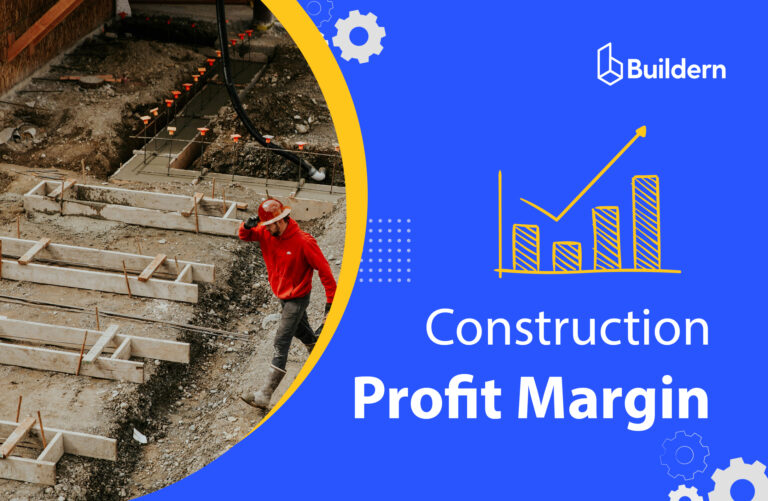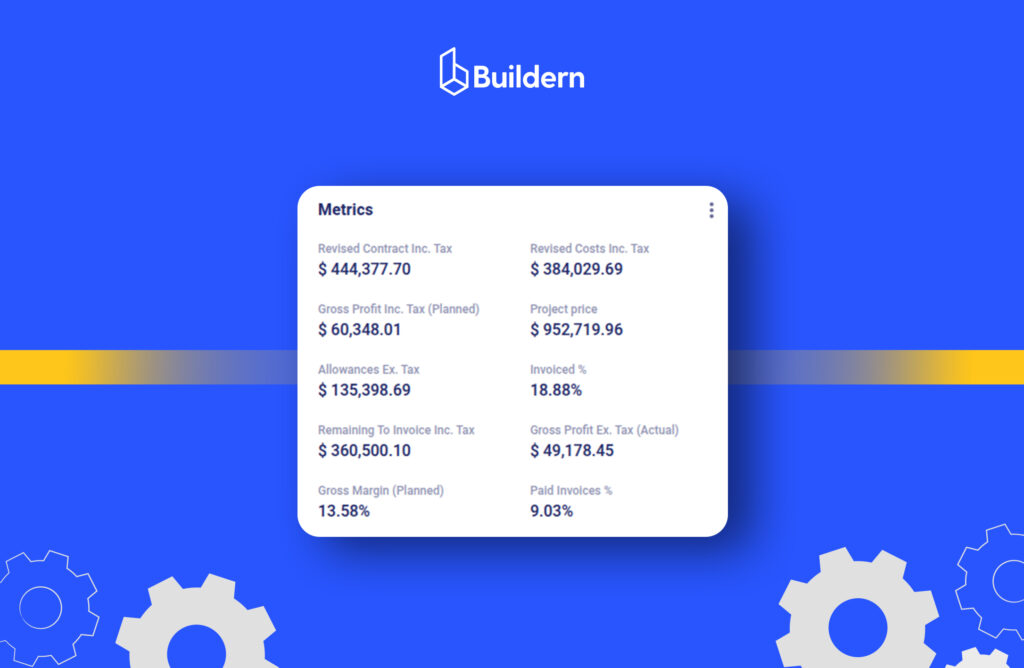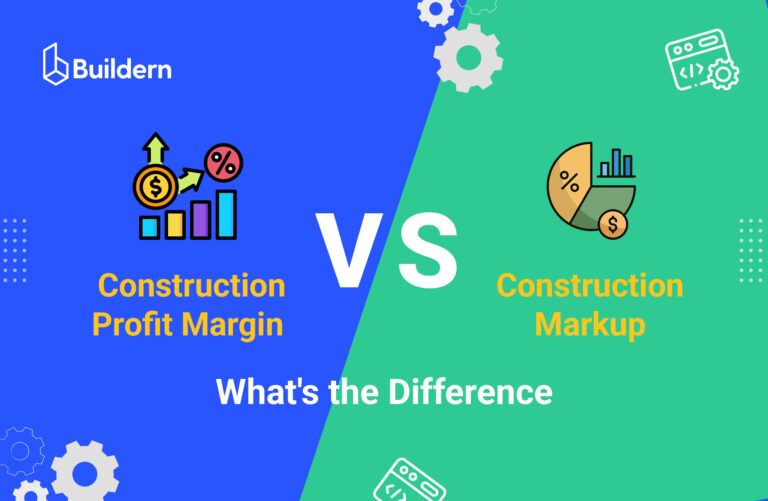Construction Profit Margin: What It Is and How to Improve Yours

Construction profit margin is one of the most important financial indicators for contractors, yet it’s also one of the most misunderstood. With unpredictable material costs, labor shortages, scope changes, and narrow bid competitiveness, turning a consistent profit in construction is becoming harder each year.
Even a minor miscalculation or delay can erode your bottom line. That’s why knowing your margins and understanding what affects them is critical to long-term success, and why the right construction financial management software plays a key role in staying on top of your numbers.
In this article, we’ll break down how profit margins work in construction, what typical benchmarks look like, why margins are often lower than expected, and most importantly, how to improve yours through better estimating, job costing, and project control.

Table of Contents
- What Is Profit Margin in Construction?
- Industry Benchmarks: What Is a Good Profit Margin in Construction?
- Markup vs. Margin: What’s the Difference?
- Why Construction Profit Margins Are So Vulnerable
- How to Improve Your Construction Profit Margin
- The Bottom Line
What Is Profit Margin in Construction?
Profit margin is the percentage of revenue your business retains after covering all costs. It reflects how effectively your company turns income into profit. In construction, this figure can be difficult to manage due to the variable nature of each project, but tracking it is essential.
There are three core profit margin types that every construction business should understand:
Gross Profit Margin
This measures the profit left after deducting direct project costs like materials, labor, and equipment. Gross margin reflects how profitable your core construction work is.
Revenue – Direct Costs / Revenue x 100
Operating Profit Margin
This margin includes both direct and indirect costs such as software subscriptions, insurance, office rent, and administrative salaries. It gives a clearer picture of how well your business is managing its operating expenses.
Operating Income / Revenue x 100
Net Profit Margin
Net profit margin shows the final amount your company earns after accounting for all expenses, including interest payments, taxes, and depreciation. This is the most comprehensive indicator of overall financial health.
Net Profit / Revenue x 100
Tracking all three margins helps construction companies understand where profit is generated or lost throughout the project and company lifecycle.
Industry Benchmarks: What Is a Good Profit Margin in Construction?
Construction operates on much tighter margins than many other industries. According to the Construction Financial Management Association (CFMA), average net profit margins across the sector typically range about 20%, depending on the business type.
While larger companies benefit from economies of scale, smaller contractors often struggle with higher overhead costs, inconsistent workflows, and less pricing power, all of which eat into profits.
Markup vs. Margin: What’s the Difference?
In construction, knowing your numbers isn’t just a financial best practice; it’s the difference between a profitable project and one that drains resources. Two of the most commonly confused terms are margin and markup. Even if they’re closely related, using them interchangeably can lead to serious pricing mistakes and inaccurate financial tracking.
Margin is the percentage of the final price that represents your actual profit, while markup refers to how much you add to your cost to determine the selling price. Here’s how they differ:
- Markup is based on cost. It tells you how much more you’re charging above what the project costs you.
- Margin is based on revenue. It shows how much of the total revenue you actually keep as profit.
👉 Let’s take a closer look:
Say, your cost for a project is $80.000.
You apply a 25% markup, which gives you a selling price of $100.000.
Your profit margin in this case is only 20%, not 25%.
This gap matters a lot: If you mistakenly calculate your markup thinking it will give you your desired margin, you could undercharge and shrink your profits without realizing it.
Key formulas:
- Markup = (Selling Price – Cost) / Cost x 100
- Margin = (Selling Price – Cost) / Selling Price x 100
💡Understanding both concepts is vital for estimating, quoting, and evaluating job performance. When you know how to work with both margin and markup, you can price projects more accurately, protect your bottom line, and make more informed business decisions.
Why Construction Profit Margins Are So Vulnerable
Construction businesses deal with tight deadlines, shifting scopes, and fluctuating material costs. Even with a solid estimate and plan in place, several factors can erode profit margins if not managed carefully. Let’s have a look at:
1. Inaccurate Estimating and Bidding
Many contractors still rely on spreadsheets or outdated estimating methods. Small input errors or overlooked costs can lead to underbidding, causing you to take on jobs with razor-thin or negative margins from day one.
Research indicates that spreadsheets are prone to errors; studies have found 88% of spreadsheets contain a great number of mistakes, often because of manual data entry and formula inaccuracies. In the context of construction estimating, such errors can have substantial financial implications, especially when dealing with complex projects involving numerous variables.
Moreover, spreadsheets lack real-time data integration and collaborative features, making it challenging to maintain consistency and accuracy across teams. This can lead to miscommunication, version control issues, and ultimately, compromised project outcomes.
2. Unmanaged or Unbilled Change Orders
Change Orders are a natural part of construction, but without a structured process to manage them, they can severely damage your profit margins. Scope creep often begins with minor client requests or unforeseen site conditions. If these changes aren’t formally documented, approved, and priced, your team may proceed with work that’s never invoiced.
Unbilled work puts your business at risk of absorbing additional costs without compensation. Over time, these missed opportunities compound, turning otherwise profitable projects into break-even projects or loss-generating efforts. A standardized digital workflow for change orders helps ensure every scope modification is reviewed, tracked, and billed appropriately.

3. Lack of Budget Oversight During Execution
Waiting until a project wraps up to review financial performance is a costly mistake. By then, the damage is done, and the opportunity to make timely adjustments is lost. Construction projects are dynamic, with costs fluctuating due to material prices, labor availability, weather disruptions, or scheduling conflicts.
Without real-time visibility into job costs, you lose control over the budget. Problems that could be corrected midstream, such as overspending in specific cost codes or inefficient labor allocation, go unnoticed. Implementing real-time budget tracking tools with live dashboards and automatic alerts gives project managers the insight they need to make informed decisions before small issues become major losses.
4. Labor Shortages and Scheduling Delays
The construction labor market remains tight, with qualified workers in high demand and short supply. This shortage increases labor costs, reliance on less experienced crews, and project delays. Additionally, unplanned absences, scheduling conflicts, and miscommunication between field crews and office staff further exacerbate delays and reduce productivity.
According to McKinsey’s report on global construction productivity, inefficiencies tied to labor and scheduling are among the leading causes of lost profit. Each day of delay adds indirect costs such as extended equipment rentals or prolonged site management that cut into your margin. Proactive workforce planning, coupled with communication tools that sync schedules and updates in real time, can help prevent these setbacks.
5. Disconnected Teams and Tools
Fragmented systems are a silent margin killer in construction. When estimating, project management, field reporting, and accounting all run on separate platforms, teams operate in silos. This leads to duplicated efforts, inconsistent data, and time wasted reconciling information between systems.
The lack of integration also delays decision-making as project managers may not have access to current cost data, while accountants lack visibility into project progress. These blind spots create friction across teams and result in costly errors, from missed change orders to misallocated expenses.
Investing in an integrated construction management platform eliminates data silos and enables seamless collaboration. When everyone from estimators to site supervisors to finance works from the same source, accountability improves, and profit-draining missteps decrease.
How to Improve Your Construction Profit Margin
In construction, thin margins aren’t always the result of overspending. More often, they come from missteps hidden in plain sight – flawed estimates, vague change orders, or delays caused by poor communication.
Improving profit isn’t just about trimming costs. It’s about gaining control.
📌 Start with Your Estimates
- Most margin erosion starts before the job even begins. Manual estimating leaves too much room for error: missed items, outdated rates, inconsistent markup. A digital tool changes that.
- You get real-time material and labor rates, cost templates, and standardized breakdowns by cost code. More importantly, you create bids that reflect actual job realities, not rough assumptions.
- Buildern’s Estimating module helps eliminate guesswork by connecting your estimates to actual cost performance, so you can build profitable bids every time.
📌 Track Job Costs in Real Time
One of the most common ways profit slips through the cracks is by catching issues too late. You complete the job, close out the books, and only then realize that labor ran over or materials exceeded the estimate.
By then, there’s nothing to do but absorb the loss.
That’s why real-time job costing matters. When site crews submit daily logs and time entries, and those feed directly into your project budget, you get an immediate snapshot of how things are tracking.
You can compare actuals to projections daily, not monthly. If framing is going over because of labor delays or unexpected waste, you’ll know early enough to course-correct; reallocate resources, renegotiate suppliers, or adjust your timeline with full visibility.
A good solution is Buildern’s financial metrics dashboard, with the help of which you can monitor not just job costs, but your gross margin, budget variances, and overall profitability as the project progresses. Metrics widgets give project managers a clear, visual snapshot of how actuals compare to estimates, updated daily.
If framing is running over due to labor delays or unexpected material waste, you’ll catch it early enough to course-correct: reallocate crews, renegotiate pricing, or adjust your schedule, with full financial context.

💡Standardize Your Change Order Workflow
Change orders are inevitable. How you handle them is what separates profitable companies from those constantly playing catch-up.
Verbal approvals, missed emails, and handwritten notes on the jobsite don’t cut it. If even one change slips through untracked, you risk doing unpaid work or throwing your schedule off without compensation.
A standardized digital workflow ensures every change is documented, approved, and reflected in the budget before anyone lifts a hammer. The pricing is clear, the timeline is updated, and everyone is aligned from the owner to the subs.
👉 Buildern’s Change Order tools ensure changes are processed consistently and don’t become profit leaks.
📌 Tighten Office-to-Field Communication
Miscommunication between the office and the field is one of the quietest, costliest issues in construction. A crew shows up with the wrong version of the plans. A foreman doesn’t see an updated RFI. Tasks get repeated or missed altogether.
These breakdowns waste hours, sometimes days, and in construction, time is money.
A centralized communication system ensures the right people always have access to the most current documents, schedules, and updates. No back-and-forth calls. No uncertainty.
Buildern connects everyone in real time. Field teams get mobile access to plans, photos, checklists, and daily logs. PMs receive instant updates. And stakeholders stay informed without micromanaging.
When the field and the office speak the same language, projects move faster, and profit margins stay intact.
📌 Align Accounting and Project Data
When accounting and project management operate in silos, errors multiply. The PM submits an invoice for 50% completion. Accounting sees only 30% on file. Payments get delayed. Cash flow stalls. Trust erodes.
Financial clarity depends on alignment.
With integrated systems, your accounting team doesn’t have to guess or chase down PMs for missing data. They see what’s been billed, what’s been approved, and what’s outstanding in real time.
Buildern integrates seamlessly with QuickBooks and Xero, ensuring consistency between your jobsite data and your financial records. That means fewer errors, faster billing cycles, and better visibility into your company’s financial health.
📌 Watch the Right Metrics
Your profit margin isn’t just shaped by how much you spend. It’s shaped by how quickly you spot inefficiencies.
Are you consistently over budget in the finishing phase? Are change orders spiking on certain job types? Is one crew outperforming another on labor productivity?
These aren’t just numbers; they’re opportunities.
Buildern gives you built-in dashboards to track key performance indicators: gross margin, labor efficiency, budget variance, schedule performance, and more. With this data at your fingertips, you can spot trends, make adjustments, and turn insights into higher profit on the next job.
💡Adopt Software That Supports Profit Control
Managing your business on disconnected tools results in missed opportunities and wasted time. Instead, adopt a construction management platform designed to support profitability, not just task management.
Buildern unites preconstruction, field operations, financial tracking, and team collaboration in one system. This means:
- Fewer errors and rework
- Improved team accountability
- Automated workflows
- Clearer insight into job performance
The Bottom Line
Construction profit margins are often tight, and external challenges like fluctuating costs, labor shortages, and project delays can make profitability even harder to maintain. However, understanding and actively managing these factors is crucial to improving your margins and securing long-term success.
By focusing on accurate estimating, real-time job costing, and better coordination across teams, you can avoid common blockers that are most likely to erode profits. Ultimately, implementing a construction management system will give you the tools to track expenses, manage Change Orders & more, and ensure that all project data is aligned. This not only improves operational efficiency but also allows for quicker decisions and improved financial oversight.
In an industry where small inefficiencies can quickly turn into major financial setbacks, staying proactive and adopting the right technology will help your margins stay in check and build a more profitable business.



